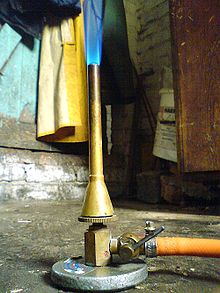 A Teclu burner | |
| Uses |
|
|---|---|
| Inventor | Nicolae Teclu |
| Material | Brass or iron |
| Related items | |
The Teclu burner is an ambient air laboratory gas burner, that was created by Romanian chemist Nicolae Teclu in 1882. The burner is most commonly used to heat substances in a laboratory, can be used for sterilisation and sometimes it is used for soldering or glasswork.[1] It is commonly made from brass or iron.[2][3]The burner physically consists of a round base, a tube connected to it providing the gas to the flame and a vertical metal tube that directs the flame upwards. The tube has a conical shape closer to the base.
The burner was created on the basis of Nicolae Teclu's previous studies on flame spectroscopy and specifically, his experiments including flames positioned at different levels in a tube. Teclu was able to conclude that changing the position of the flame in a vertical tube can effect the splitting of the flame and optimize the heat produced by the flame. As a result of this alteration, this burner compared with the Bunsen burner is able to produce higher flame temperatures: around 2,900 °F (1,600 °C; 1,850 K).[1][4] The research behind the creation of this burner was first published in 1892. There are some early Teclu burners on display in the Virtual Gas Museum in Poland[5] and also in the Science Museum, London.
- ^ a b Cite error: The named reference
:1was invoked but never defined (see the help page). - ^ Cite error: The named reference
:4was invoked but never defined (see the help page). - ^ Cite error: The named reference
:0was invoked but never defined (see the help page). - ^ Mandal Pratim Partha; B. Mandal (1 January 2001). A Text Book of Homoeopathic Pharmacy. B. Jain. p. 46. ISBN 978-81-7381-009-1.
- ^ Cite error: The named reference
:3was invoked but never defined (see the help page).